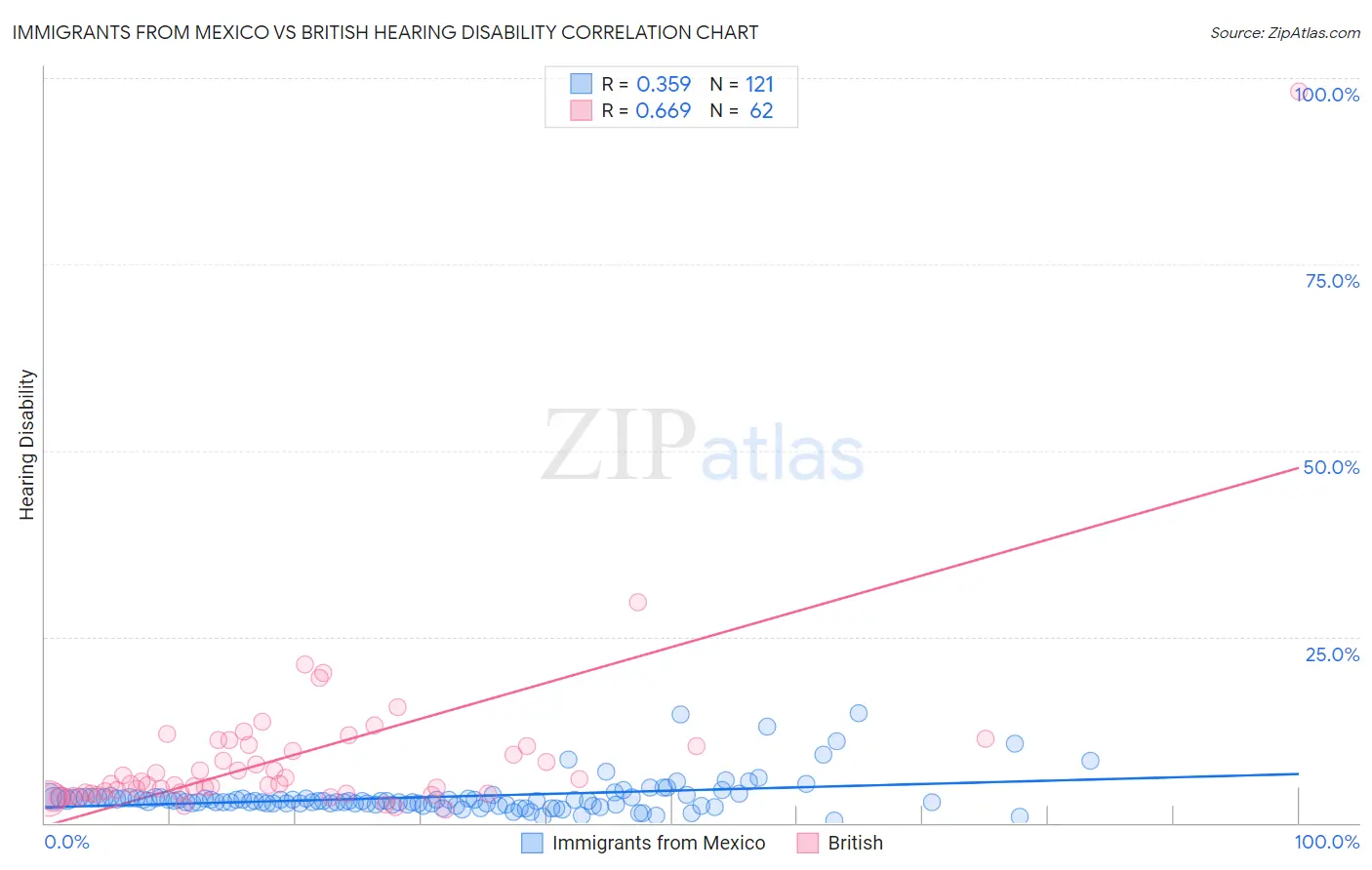Immigrants from Mexico vs British Hearing Disability
COMPARE
Immigrants from Mexico
British
Hearing Disability
Hearing Disability Comparison
Immigrants from Mexico
British
3.0%
HEARING DISABILITY
34.9/ 100
METRIC RATING
186th/ 347
METRIC RANK
3.5%
HEARING DISABILITY
0.1/ 100
METRIC RATING
265th/ 347
METRIC RANK
Immigrants from Mexico vs British Hearing Disability Correlation Chart
The statistical analysis conducted on geographies consisting of 513,280,828 people shows a mild positive correlation between the proportion of Immigrants from Mexico and percentage of population with hearing disability in the United States with a correlation coefficient (R) of 0.359 and weighted average of 3.0%. Similarly, the statistical analysis conducted on geographies consisting of 531,095,023 people shows a significant positive correlation between the proportion of British and percentage of population with hearing disability in the United States with a correlation coefficient (R) of 0.669 and weighted average of 3.5%, a difference of 14.3%.

Hearing Disability Correlation Summary
| Measurement | Immigrants from Mexico | British |
| Minimum | 0.32% | 1.8% |
| Maximum | 14.7% | 98.2% |
| Range | 14.4% | 96.4% |
| Mean | 3.5% | 8.9% |
| Median | 3.0% | 5.3% |
| Interquartile 25% (IQ1) | 2.5% | 4.0% |
| Interquartile 75% (IQ3) | 3.4% | 10.4% |
| Interquartile Range (IQR) | 0.88% | 6.4% |
| Standard Deviation (Sample) | 2.4% | 12.7% |
| Standard Deviation (Population) | 2.4% | 12.6% |
Similar Demographics by Hearing Disability
Demographics Similar to Immigrants from Mexico by Hearing Disability
In terms of hearing disability, the demographic groups most similar to Immigrants from Mexico are Black/African American (3.0%, a difference of 0.010%), Mexican American Indian (3.0%, a difference of 0.020%), Immigrants from Southern Europe (3.0%, a difference of 0.050%), African (3.0%, a difference of 0.21%), and Immigrants from Ireland (3.0%, a difference of 0.25%).
| Demographics | Rating | Rank | Hearing Disability |
| Immigrants | Moldova | 43.1 /100 | #179 | Average 3.0% |
| Immigrants | Sweden | 42.4 /100 | #180 | Average 3.0% |
| Immigrants | Belgium | 41.5 /100 | #181 | Average 3.0% |
| Immigrants | Italy | 41.1 /100 | #182 | Average 3.0% |
| Bulgarians | 39.7 /100 | #183 | Fair 3.0% |
| Immigrants | Ireland | 37.4 /100 | #184 | Fair 3.0% |
| Immigrants | Southern Europe | 35.3 /100 | #185 | Fair 3.0% |
| Immigrants | Mexico | 34.9 /100 | #186 | Fair 3.0% |
| Blacks/African Americans | 34.7 /100 | #187 | Fair 3.0% |
| Mexican American Indians | 34.7 /100 | #188 | Fair 3.0% |
| Africans | 32.9 /100 | #189 | Fair 3.0% |
| Immigrants | South Africa | 31.1 /100 | #190 | Fair 3.1% |
| Immigrants | Switzerland | 28.8 /100 | #191 | Fair 3.1% |
| Koreans | 27.6 /100 | #192 | Fair 3.1% |
| Macedonians | 27.0 /100 | #193 | Fair 3.1% |
Demographics Similar to British by Hearing Disability
In terms of hearing disability, the demographic groups most similar to British are Immigrants from Germany (3.5%, a difference of 0.020%), Belgian (3.5%, a difference of 0.18%), Immigrants from Canada (3.5%, a difference of 0.24%), Immigrants from North America (3.5%, a difference of 0.28%), and Hawaiian (3.5%, a difference of 0.39%).
| Demographics | Rating | Rank | Hearing Disability |
| Northern Europeans | 0.2 /100 | #258 | Tragic 3.4% |
| Slovenes | 0.1 /100 | #259 | Tragic 3.5% |
| Portuguese | 0.1 /100 | #260 | Tragic 3.5% |
| Hawaiians | 0.1 /100 | #261 | Tragic 3.5% |
| Immigrants | North America | 0.1 /100 | #262 | Tragic 3.5% |
| Immigrants | Canada | 0.1 /100 | #263 | Tragic 3.5% |
| Immigrants | Germany | 0.1 /100 | #264 | Tragic 3.5% |
| British | 0.1 /100 | #265 | Tragic 3.5% |
| Belgians | 0.1 /100 | #266 | Tragic 3.5% |
| Canadians | 0.1 /100 | #267 | Tragic 3.5% |
| Spaniards | 0.1 /100 | #268 | Tragic 3.5% |
| Ute | 0.1 /100 | #269 | Tragic 3.5% |
| Europeans | 0.1 /100 | #270 | Tragic 3.5% |
| Czechs | 0.1 /100 | #271 | Tragic 3.5% |
| Fijians | 0.0 /100 | #272 | Tragic 3.5% |